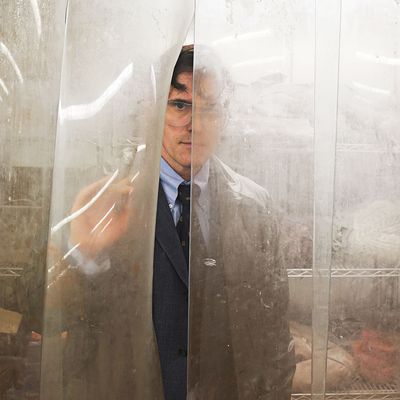
Some spoilers follow for The House That Jack Built, but they also put a ton of this shit in the trailer, so. This post originally ran during the Cannes Film Festival.
Last night at the Cannes Film Festival, as reports started to circulate that a hundred people had walked out of the black-tie premiere of Lars von Trier’s serial-killer film The House That Jack Built, I ran into one of the escapees. He was flustered, indignant, and still trying to get into von Trier’s after-party. How violent was the film, I asked him? The man shook his head: “He mutilates Riley Keough, he mutilates children … and we are all sitting there in formal dress, expected to watch it?”
Perhaps the casually attired press is made of sterner stuff because The House That Jack Built also screened for journalists this morning, and this time around, very few people walked out. Certainly, the film is violent, and often outright appalling: On a scale from Paddington 2 to that awful skinning scene in Red Sparrow, The House That Jack Built squats as far to the right side as possible. Still, as I walked out of the press screening today, plenty of journalists were shrugging. “That wasn’t as bad as I expected,” one told me. “Maybe I disassociated?” mused another. Or maybe, as my colleague Emily Yoshida noted, “You can only tell yourself those mangled children’s corpses are fake so many times before the rest of the film feels fake as well.” (Yup, there are mangled children’s corpses in The House That Jack Built. Did you expect Lars von Trier to go easy on you?)
It’s natural to wonder, then, which audience had it right: the scandalized swells at the premiere who called The House That Jack Built an abomination and fled for the aisles, or the bleary-eyed journalists at the press screening, who never once upchucked. Exactly how violent is this violent movie?
To answer that question, I’ll tell you about four of the most talked-about sequences in the film, leaving you to judge whether your stomach can take it. Obviously, there are spoilers, but this movie is literally just a series of killings with some didactic voice-over now and then. It’s not exactly a story of twists and turns, unless what you’re most curious about is the volume of arterial spray.
1. The tamest killing in this film is the first, as well as the starriest: Uma Thurman plays a woman with car trouble who has the bad luck of running into Matt Dillon’s serial killer on the road. Her car jack is busted, and she pleads with Dillon to drive her to someone who could repair it, but the more time the two of them spend together, the more Thurman begins to get on his nerves. She’s a needy ball-buster who calls Dillon a wimp, and since this is an incel murder fantasy, of course she must die. Dillon smashes her face with the broken car jack, a moment that is replayed over and over again throughout the movie. It’s worth noting that von Trier stacks the deck so considerably against Thurman’s character — as well as every female character in the movie, since they’re portrayed as dim, hectoring, or both — that a few members of the press-screening audience clapped when Dillon attacked her.
2. Every so often in the film, von Trier flashes back to a child version of Dillon’s character, and in one such interlude, the boy takes a duckling and snips off one of its legs, a truly horrible shot that looks real as can be. A budding sociopath, he then sets the duckling back in the water and watches it struggle to swim. Suffice it to say, von Trier won’t be getting PETA’s cosign for this film.
3. The worst sequence in the film comes in the middle, where Dillon takes a woman and her two sons out for a picnic. In this scene — which has become instantly notorious on the Croisette — Dillon tells the boys that when shooting deer, you must target the smaller fauns before picking off the mother. (Sadly, they are the only ones who can’t pick up on his foreshadowing.) In no time, Dillon is hunting the family down, and von Trier shoots much of the sequence through the periscope of Dillon’s rifle as he trains it on the children and pulls the trigger. Once they are slain, Dillon lays the boys on the picnic cloth and forces their distraught mother to spoon-feed them lunch, then goes after her, too. Much of the violence in this film comes in brief spasms, but von Trier reeeeeally lingers on the children’s corpses here, panning up and down their bodies as though he were directing a lascivious advertisement. More terrible things happen in this sequence and its aftermath, but those shots are the undisputed height — or low — of von Trier’s tastelessness.
4. And then there’s Riley Keough. The American Honey actress appears as a woman who dates the creepy Dillon, despite the fact that he humiliates her and refuses to actually use her name, preferring instead to call her “Simple.” The one thing about her that both Dillon and von Trier care about are the woman’s “great tits,” and eventually, Dillon pulls down her blouse and makes incision marks around them with a red marker. You can guess where that one’s going to go, even if Keough takes too long to catch up. As she screams, he soliloquies, telling her that “men are the real victims.” Whether that sentiment is more egregious than the fact that he later turns one of her breasts into a wallet … well, that’s for you to decide.

